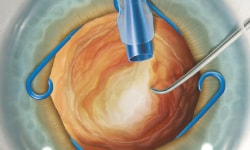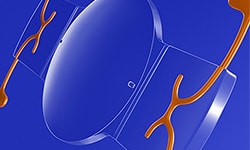Editorially Independent Content
The Centurion Vision System (Alcon) is a phacoemulsification platform for use in cataract surgery. Centurion shares a familiar look and feel with other products in Alcon’s cataract and refractive suite, and it integrates well with the other technologies in the operating room. The system’s OZil IP handpiece and INTREPID Balanced Tip enable a more efficient removal of the lens during surgery. And Centurion’s Active Fluidics technology actively regulates intraocular pressure (IOP) with a feedback loop to maintain it in an active state rather than relying on gravity flow to keep fluid in the eye. This enables a more stable anterior chamber, which makes surgery easier, faster and more efficient.
SEAMLESS WORKFLOW INTEGRATION
At our practice, we’ve had the Centurion Vision System since it was first released and have been using it in our operating room for about one year now. When we first realized that we needed a new phacoemulsification system, we considered several options but decided to go with the Centurion.
The Centurion is part of what Alcon calls its Cataract and Refractive suite of products. Since we were already set up for Alcon products in our OR, such as the INFINITI Vision System, upgrading from that machine to Centurion was a natural transition for us. And, given our familiarity with the look and feel of Alcon products, it was also an easy transition surgically.
The Centurion also integrated well with the other Alcon products we were using, including the LenSx, Verion intraoperative tracking devices and microscopes. Using their suite of products does make it easier for one to flow into another, which adds to our speed in the operating room.
ADVANCED TORSIONAL & FLUIDICS TECHNOLOGY
The Centurion integrates technology that is greatly advanced compared to INFINITI. With the INFINITI, torsional technology was sort of pushed on that machine and made to work; whereas, Centurion was designed around Alcon’s OZil IP torsional technology that optimizes energy delivery during surgical procedures.
With Alcon’s OZil torsional technology and the balanced tip of their ergonomic handpiece, called the INTREPID Balanced Tip, you will see a more efficient removal of the lens.
The Active Fluidics technology on Centurion is also greatly improved giving you a much more stable anterior chamber, which makes surgery easier, faster and more efficient. Instead of hanging solution of irrigating fluid from the ceiling, Centurion puts it into a cartridge that has compression plates that actively regulate intraocular pressure with a feedback loop. You are actually maintaining pressure in an active state, not relying on gravity flow to keep fluid in the eye. This gives you a more stable anterior chamber, which is a big change from prior generation phaco machines—one that I believe users will notice immediately.
GREATER SAFETY AND STABILITY
In my practice, the most common procedure we do is cataract surgery. We also do a lot of corneal surgery with endothelial transplants, and having a stable anterior chamber is helpful there. We also do a lot of anterior segment reconstruction and having improved fluidics there is even more critical than in traditional cataract surgery.
Much of my practice revolves around complex cases and management of surgical complications, and the Centurion’s many advantages are fantastic for this aspect of my practice. Its improved vitrector makes removing vitreous a safer, faster and more efficient process. The vitrector’s cut rate is now up to 4,000 and it’s a 23-gauge vitector, so it goes through much smaller incisions. For me, the vitrector is a lifesaver.
Most people don’t like to show off how much they do anterior vitrectomy as it is typically seen as a complication in cataract surgery. If you do enough surgery the situation will arise when vitrectomy is necessary. It is in those situations that you need to rely on a high quality anterior vitrector and the vitrector on the Centurion, will help get you out of a jam. It allows me to do things that I couldn’t safely or easily do with prior generation machines.
What I like best about the Centurion is that it delivers as promised. There is a noticeable difference in stability in the anterior chamber, the phacoemulsification efficiency is greatly improved and it really does make surgery faster and easier. Using the Centurion makes complicated cases easier and standard cases even safer, more stable and more efficient.
POTENTIAL CHALLENGES
While the integration of the Centurion is pretty easy, the graphical user interface is slightly more complicated, you can get a bit lost if you don’t know what you’re doing before you start surgery. So, you should not expect to just get it, unwrap it and start using it right away in your operating room. I’d really make sure you’re familiar with the machine and user interface.
We also had a problem linking the Centurion’s wireless foot pedal to the machine itself. It never impacted patient safety because we were always aware of the problem before we started surgery and simply plugged the pedal in.
I would strongly recommend having an Alcon representative help you set the machine up. Especially now that we’re using IOP in place of bottle height,, you want to make sure that you have the machine set up correctly. If your not careful you can get lost in the operating system and you may lose out on it’s surgical advantages. .
WORTHY OF RECOMMENDATION
Since cataract surgery is really molding into refractive surgery, having a machine like the Centurion helps accomplish that goal. We haven’t unlocked all of its power yet. More updates will be coming, so it will be interesting to see what happens over the next five years because this is a machine that’s built to grow.
We’ve been very, very happy with the Centurion, and I think it’s head and shoulders above the rest as far as phaco machines go. I have already recommended it to several of my colleagues and some of them who purchased the machine have gotten back to me saying, thank you for the good recommendation.





